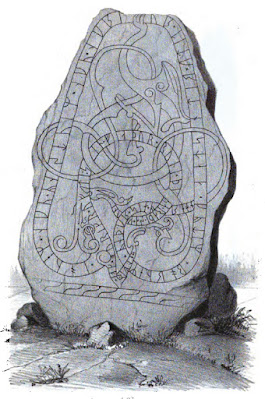So last night I met up with a friend of mine for a beer after dealing with a very busy day at work. I'm supposed to put all of this & more on social media. Frankly, I'd rather spend the time with some of my Dragon magazines instead. Which brings me to Dragon magazine issue #182, incase you don't know 'Dragon issue 182, 16th Anniversary Issue: Dragons: born of imagination, was released in June of 1992. ' according to it's Forgotten Realms's Wiki entry here.
An overview of the Norse lands' great serpents, part 1. [citation template]
- Forest linnorm
- Land linnorm
- Sea linnorm
- Frost linnorm
- Dread linnorm
In Fáfnismál, the dragon Fáfnir is described as flightless and snake-like, and is referred to as an ormr.[3][4] In the later Völsunga saga, however, he has shoulders, suggesting legs, wings or both, and is referred to as both a dreki and an ormr.[5] Similarly, the dragon in Beowulf is referred to as both a wyrm and a draca, although in some sources such as Ketils saga hœngs and the 14th century romance saga Konráðs saga keisarasonar, ormar and drekar are portrayed as distinct beings, with winged dragons sometimes specified as flogdreka (flying dragons).[6] Old Norse dreki and Old English draca mean "dragon, sea serpent or sea monster" and are in turn derived from Proto-Germanic *drakō, an early borrowing from Latin draco "huge serpent or dragon".[7][8][9]
The evolution of wingless and legless worms and lindworms to flying, four-legged romanesque dragons in Germanic folklore and literature is most likely due to influence from continental Europe that was facilitated by Christianisation and the increased availability of translated romances. It has thus been proposed that the description in Völuspá of Níðhöggr with feathers and flying after Ragnarök is a late addition and potentially a result of the integration of pagan and Christian imagery."
So basically we have the full picture of where these wyrms may have originated. But are they still active!?!
In my own campaigns?! Oh yes absolutely they are. These things are demigod killers especially within a game such as Adventurer, Conqueror, King rpg. These dragons are also perfectly suited to ACK's Heroic Fantasy Handbook where the dragons are almost but not quite god destroyer problems. And this goes right back to the original Germanic Dragons of mythology; "The evolution of wingless and legless worms and lindworms to flying, four-legged romanesque dragons in Germanic folklore and literature is most likely due to influence from continental Europe that was facilitated by Christianisation and the increased availability of translated romances. It has thus been proposed that the description in Völuspá of Níðhöggr with feathers and flying after Ragnarök is a late addition and potentially a result of the integration of pagan and Christian imagery"
The Viking Wryms are continued in Dragon issue #183 in The Viking Dragons By Jean Rabe, illustrated by Jim Holloway. p. 65-70
The continuation of the Viking Dragons has some really dangerous & nasty examples of the species & we get the following according to the Forgotten Realms Wiki entry here:
An overview of the Norse lands' great serpents, part 2.
- Flame linnorm
- Gray linnorm
- Rain linnorm
- Corpse tearer
- Midgard linnorm




No comments:
Post a Comment
Note: Only a member of this blog may post a comment.